The impact of inflation on the renovation and construction habits of Poles - REPORT 2023

Ramirent's analytical team carried out a study of renovation habits in times of inflation, from which a report was produced. The aim of the study was to verify how inflation has affected renovation and construction plans.
An additional aspect of the survey was to find out how far in advance renovations are planned, which rooms are renovated most often and how many people, due to rampant inflation, are looking to save money by, for example, forgoing renovation and construction teams in favour of doing the renovation or finishing work themselves.
Key findings of the survey:
- 42.5% of respondents decided to postpone or suspend renovation and construction work due to inflation.
- Most residents in the Pomorskie, Wielkopolskie and Podlaskie regions decided to postpone or suspend their renovation plans.
- As a result of inflation, 34.2%, people carried out less renovation than they had originally planned. 32.4% of respondents decided to renovate on their own, and 17.4% of them postponed renovation work.
- In the last 3 years, the highest number of people (34%) spent between PLN 15,000 and PLN 19,999 on renovations. Relatively most expensive renovations in this range were declared by residents of Podlasie - as much as 82.6% of respondents from this voivodeship declared this.
- The most common problem encountered by respondents during renovations was unavailability of construction materials (38%). Slightly fewer, 36.3%, indicated a significant increase in the price of building materials.
- More than half of the respondents declared problems with the availability of construction and renovation teams.
- The most frequently renovated room in Poland is the living/dining room (37.1%). The least frequently renovated room is the bedroom (4.1%).
- 82.8% of respondents use professionals when renovating.
- Most, i.e. 33.1% of respondents renovate with a frequency of once in 4-5 years. 24.8% - once every 6-10 years and 22.1% - once every 1-3 years.
- Poles most often finance renovations with funds obtained from bank loans - 37.6% of respondents do so.
- Most respondents (39.3%) plan their refurbishment 12 months in advance.
In which provinces have most people chosen to postpone renovation due to inflation?
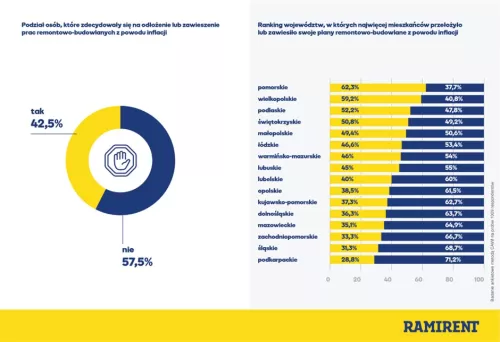
According to the CSO, inflation averaged 14.8% in 2022. Recent months have brought some 'stabilisation', but the readings do not inspire optimism - in December 2022, the price growth rate reached 16.6%. This compares with an average inflation rate of 5.1% in the same period of 2021.
Renovations are therefore becoming more and more expensive. This does not change the fact that, even though they are expensive, they are sometimes simply necessary. However, the impact of inflation is clearly visible - both in expenditure and in plans for renovation and construction work.
As many as 42.5% of respondents declared that they had to cancel or postpone renovation and construction work due to inflation. 57.5% did not change their plans.
The survey took into account the place of residence of the respondents. This made it possible to develop a ranking of the provinces whose residents were most likely to opt out of renovation (either temporarily or completely).
Most people, 62.3%, made such a decision in the Pomorskie Voivodeship. An equally high percentage of respondents postponed or abandoned renovation in the Wielkopolskie (59.2%), Podlaskie (52.2%), and Świętokrzyskie (50.8%) voivodeships.
Almost half (49.4%) of respondents in Małopolska and Łódzkie (46.6%) also made such a decision. This was followed by Warmińsko-Mazurskie (46%), Lubuskie (45%), Lubelskie (40%), Opolskie (38.5%), Kujawsko-Pomorskie (37.3%), Dolnośląskie (36.3%) and Mazowieckie (35.1%).
The Western Pomeranian (33.1%), Silesian (31.3%) and Subcarpathian (28.8%) Voivodeships round out the list. This is where the fewest people of all those surveyed decided to postpone or abandon renovation and construction work.
It is worth noting that, irrespective of the voivodeship, a minimum of ¼ of people have given up renovations as a result of inflation. The lowest percentage of such respondents is 28.8% in Podkarpacie. In as many as four voivodeships (Pomorskie, Wielkopolskie, Podlaskie and Świętokrzyskie), more than half of the residents had to change their plans. As the study has shown, the scale of this phenomenon is very large across the country.
How does inflation affect Poles' renovation plans?

Inflation can be predicted - if you work in the field of economics and are good at your job. For most average Kowalskis, the sudden rise in prices came as a surprise and forced them to change their plans - including those for renovations. The survey showed exactly how inflation has affected Poles' renovation plans.
It turns out that the majority of respondents, 34.2% to be exact, decided to do a smaller renovation. 32.4% of respondents decided to renovate on their own and 17.4% postponed renovation work. 14.5% of respondents bought cheaper building materials due to inflation. Only 1.5% of people gave up renovating altogether.
An analysis was also made of which voivodeships respondents most often decided to carry out smaller renovations. In this respect, residents of the Warmian-Masurian voivodeship lead the way - as many as 50% of them decided to carry out renovation work on a smaller scale as a result of inflation. They were followed by the West Pomeranian (48.9%), Opole (48.1%), Lubuskie (41.7%) and Świętokrzyskie (41.3%) voivodeships.
Further places in the ranking do not mean drastically lower values. The decision to renovate less was taken by 40% of residents in the Lubelskie voivodeship, 37.3% in the Podkarpackie voivodeship, 34.8% in the Podlaskie voivodeship, 34.7% in the Wielkopolskie voivodeship, 34% in the Pomorskie voivodeship, 32% in the Kujawsko-Pomorskie voivodeship, 31% in the Łódzkie voivodeship and 26% in the Mazowieckie voivodeship.
The ranking is closed by the following voivodeships: Śląskie (25%), Małopolskie (23.5%) and Dolnośląskie (Lower Silesia), where the smallest number of people decided to do less renovation - 21.6%. It is therefore easy to see that in each of the voivodeships, as a result of inflation, a minimum of ⅕ of residents have carried out renovation and construction work on a smaller scale than would have resulted from the original plans.
What problems have Poles most frequently encountered during renovation and construction work in the last 3 years?
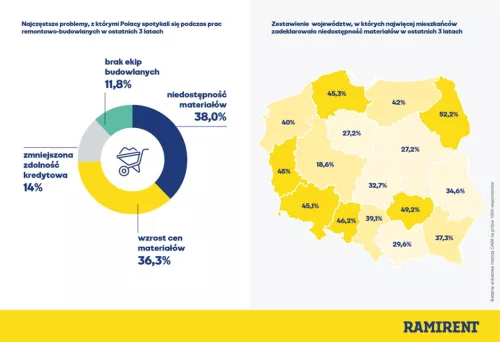
To, że w trakcie remontu pojawiają się różnego rodzaju trudności lub nieprzewidziane wydatki, nie jest niczym nadzwyczajnym. Inflacja sprawiła jednak, że Polacy muszą mierzyć się z tego typu wyzwaniami na większą niż do tej pory skalę.
Najczęstszy problem, z którym ankietowani spotkali się podczas remontów w okresie ostatnich 3 lat, to problemy z dostępnością materiałów budowlanych – taką opcję zadeklarowało 38% z nich. Jako drugi powód najczęstszych i nieprzewidzianych problemów podczas remontów ankietowani wskazywali na wzrost cen materiałów budowlanych (36,3%). 14% osób zadeklarowało zmniejszoną zdolność kredytową, prawie 11,8% jako główny problem wskazało brak fachowców.
W badaniu wykazano także, w jakich regionach mieszkańcy najczęściej stykali się z niedostępnością materiałów budowlanych. Okazuje się, że doświadczyła tego ponad połowa, bo aż 52,2% ankietowanych z województwa podlaskiego. Zetknęło się z tym także 49,2% mieszkańców województwa świętokrzyskiego, 46,2% – opolskiego, 45,3% – pomorskiego, 45,1% – dolnośląskiego i 45% – lubuskiego.
Nieco mniejszy, ale wciąż znaczący odsetek osób, spotkał się z problemem niedostępności materiałów w województwach warmińsko-mazurskim (42%), zachodniopomorskim (40%), śląskim (39,1%), podkarpackim (37,3%), wielkopolskim (34,7%), lubelskim (34,6%) i łódzkim (32,7%).
Najmniej ankietowanych z województwa kujawsko-pomorskiego spotkało się z problemem niedostępności materiałów budowlanych – 18,6%. W województwie mazowieckim tego zjawiska doświadczyło – 27,2%, a w małopolskim – 29,6%.
Ile średnio Polacy wydawali na remonty w ostatnich 3 latach?

Refurbishments have become significantly more expensive in recent years. Inflation and problems with the availability of raw materials have contributed to this. So how much have Poles actually spent on renovations over the last three years?
A total of 86.7% of respondents declare renovation expenses of at least PLN 10 thousand. It turns out that most people (34%) spend between PLN 15,000 and 19,999 on this type of work. 27% of respondents spend between PLN 10,000 and PLN 14,999, and 25.7% spend more than PLN 20,000.
By far the fewest people chose the lowest possible answer. Only 3.8% of respondents spent less than PLN 5,000 on renovations in the last 3 years. On the other hand, 9.4% of respondents declared expenditure at the level of PLN 5 000-9 999. It can therefore be assumed that one in ten people in Poland has given up on a large and costly renovation, moving towards a gentle refreshment of the appearance of the rooms, most likely due to the rising prices of materials and construction crews.
Analysts have also verified in which voivodeships the largest number of people have spent more than PLN 15,000 on renovation and construction works over the past three years.
The results are unambiguous - the largest amount of money was spent on renovations in the Podlaskie Voivodeship in the recent period.
As much as 82.6% of persons from Podlasie region spent more than PLN 15 000 on them in the last 3 years. It is worth noting that it was shown above that the residents of this region are among those who most often postponed their renovation plans or abandoned them altogether. It is also in Podlasie that residents are most often faced with the unavailability of building materials. The high expenses are not necessarily related to the alleged affluence of the Podlaskie residents' wallets - but to the reality of the renovation industry in the region.
The Świętokrzyskie (73%), Lubelskie (68%), Pomorskie (67.9%), Wielkopolskie (67.3%), Opolskie (61.5%) and Podkarpackie (61%) voivodeships also ranked high. 60% of residents in the West Pomeranian Voivodeship spent more than PLN 15 000 on renovations in the last three years, 56.9% in the Łódzkie Voivodeship, 56% in the Warmińsko-Mazurskie Voivodeship, 54.9% in the Dolnośląskie Voivodeship, 53.4% in the Kujawsko-Pomorskie Voivodeship, 53.3% in the Lubuskie Voivodeship, 53.1% in the Małopolskie Voivodeship and 51.9% in the Mazowieckie Voivodeship.
The ranking is closed by the Śląskie Voivodeship. 48.4% of the inhabitants of this region declare that they have spent more than PLN 15 thousand on renovations over the last 3 years. This is the only voivodeship from which less than half of the people allocated less than PLN 15 thousand for renovation works.
Which rooms do Poles renovate most often?
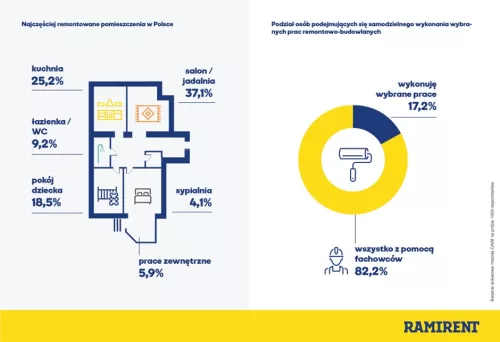
The most frequently renovated room appeared to be the living/dining room, which is the place where we spend the most time and, in theory, indulge in relaxation. This option was indicated by 37.1 % of respondents.
The kitchen came second with 25.2%, followed by the children's room (18.5%). The next places belong to the bathroom/WC (9.3%), the outdoor room (5.9%) and the bedroom (4.1%).
Do Poles renovate these rooms themselves or do they use professionals to do so?
Ramirent's analysts also decided to ask respondents whether they are able to carry out renovations on their own or whether they need the support of professionals to do so. It turns out that 82.8% of the respondents use the help of professionals when renovating. Only 17.2% carry out renovation and construction work on their own.
How often are renovations carried out in Poland?
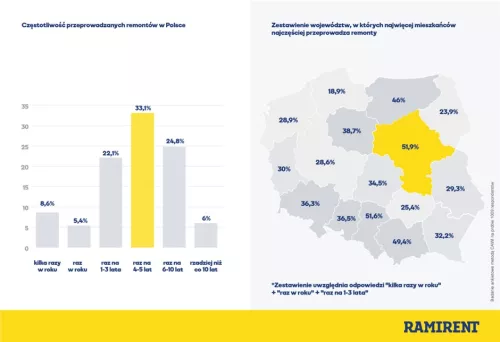
Most respondents, 33.1%, carry out renovations with an average frequency of once every 4-5 years. 24.8% - once every 6-10 years and 22.1% - once every 1-3 years.
The fewest people renovate once a year (5.4%). Interestingly, respondents more often chose the answer "several times a year". - this was declared by 8.6% of them. This may be due to carrying out small renovations and repairs to their home during the year. 6% of respondents carry out renovations with the least frequency, i.e. less frequently than every 10 years.
The researchers looked at the residences of people who declared that they carry out renovations relatively often - i.e. several times a year, once a year and once every 1-3 years.
It turns out that residents of the Mazowieckie Voivodeship renovate most frequently. As many as 51.9% of them renovate with the aforementioned frequency. This is followed by people from the Śląskie (51.6%), Małopolskie (49.4%) and Warmińsko-Mazurskie voivodeships (46%).
At least once every 1-3 years, renovation and construction works are carried out by 38.7% of residents in the Kujawsko-Pomorskie Voivodeship, 36.5% in the Opolskie Voivodeship, 36.3% in the Dolnośląskie Voivodeship, 34.5% in the Łódzkie Voivodeship, 32.2% in the Podkarpackie Voivodeship, 30% in the Lubuskie Voivodeship, 29.3% in the Lubelskie Voivodeship, 28.9% in the Zachodniopomorskie Voivodeship, 28.6% in the Wielkopolskie Voivodeship, 25.4% in the Świętokrzyskie Voivodeship and 23.9% in the Podlaskie Voivodeship.
The inhabitants of the Pomorskie Voivodeship are least likely to renovate (18.9%). This is the only region where this indicator was below 20%.
It is worth noting at this point that the survey also showed that as many as 62.3 per cent of Pomeranians, the highest number in the entire country, had made the decision to postpone renovation or to abandon it altogether.
Where do Poles get money for renovations from?

It is difficult to find an area of the economy that is not significantly affected by inflation. However, the construction industry has been particularly affected by it. The PSB Group's analysis of the prices of building materials shows that from January to December 2022, the prices of building materials increased on average by 25% compared to the same period in 2021. The biggest increase, by 42%, was in the prices of thermal insulation. The least expensive were OSB and timber - by 10%.
How do Poles finance renovations in the face of such prices? Own money is not at all in the first place. Most respondents (37.6%) pay for renovations with funds from a bank loan.
Savings came only second. These are used to finance the renovation by 28.6% of respondents. 26.9% pay for renovations with loans from family and relatives. On the other hand, 6.9% finance it through various bonuses and one-off cash injections.
Thus, it can be seen that as many as 64.5 per cent of people pay for renovations with borrowed money - either from a bank or from private individuals.
There is no doubt that the relatively high cost of renovations makes it worth planning well in advance. So how long do Poles take to prepare for them?
Most respondents plan renovations 12 months in advance - 39.3% do so. The second largest group is made up of respondents who prepare for renovation and construction work 6 months in advance (37.8%).
7.9% of respondents need 3 months to prepare, 7.5% need a month or less, and the least (7.4%) need more than 12 months.
Which provinces have the greatest shortage of professionals in times of high inflation?
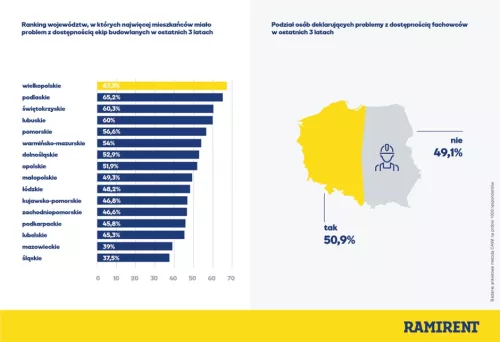
One of the main problems that Poles experience during renovations is the unavailability of professionals. This was experienced by more than half of the respondents. This type of problem was not experienced by only 49.1% of respondents.
Analysts checked in which voivodeships this phenomenon occurs most frequently. The ranking opens with Wielkopolskie voivodship, where as many as 67.3% of respondents experienced problems with availability of construction crews. Residents of Podlaskie (65.2%), Świętokrzyskie (60.3%) and Lubuskie (60%) voivodeships were also frequently affected.
This problem is also declared by 56.6% of the inhabitants of the Pomorskie Voivodeship, 54% of those of the Warmińsko-Mazurskie Voivodeship, 52.9% of those of the Dolnośląskie Voivodeship, 51.9% of those of the Opolskie Voivodeship, 49.3% of those of the Małopolskie Voivodeship, 48.2% of those of the Łódzkie Voivodeship, 46.8% of those of the Kujawsko-Pomorskie Voivodeship, 46.6% of those of the Zachodniopomorskie Voivodeship and 45.8% of those of the Podkarpackie Voivodeship.
The unavailability of construction crews was experienced least often by residents of the Lubelskie (45.3%), Mazowieckie (39%) and Śląskie (37.5%) voivodeships.
However, it is worth noting that even the lowest value is still a figure that indicates that more than ⅓ of a given province has encountered the unavailability of construction teams. The scale of this phenomenon is therefore very large.
Summary
The above report leaves no doubt that inflation has a strong influence on how we carry out renovations. It is no surprise that this impact is negative.
The unfavourable economic situation is mainly reflected in how Poles carry out their renovation plans, how much money they allocate to them and how much they are able to do for a predetermined amount. Here are the most interesting findings in this regard:
- The majority of respondents admitted that they had changed their renovation plans as a result of the price surge - deciding on a smaller renovation, buying cheaper building materials or postponing it.
- Due to inflation, a minimum of ⅕ of the Polish population carried out renovation and construction work on a smaller scale.
- As a result of inflation, a minimum of ¼ of people gave up renovation (temporarily or permanently). In four voivodeships (Pomorskie, Wielkopolskie, Podlaskie and Świętokrzyskie), more than half of the residents changed their plans.
- A total of 86.7% of respondents declared renovation expenses of at least PLN 10,000. In the last 3 years, most people (34%) spent between PLN 15,000 and PLN 19,999 on renovation.
- 38% of respondents experienced unavailability of building materials. Slightly fewer people (36.3%) experienced a significant increase in their prices.
- In addition to the increase in the price of materials, issues with the unavailability of construction crews are also proving to be a significant problem, as indicated by more than half of the respondents.
- Inflation is causing Poles' savings to melt away. Perhaps this is the reason for the fact that a total of 64.5% of people finance renovations with borrowed money and most of them plan them well in advance - a minimum of 12 months.
Ramirent's analysts also observed a number of regularities related to the impact of inflation on renovations in specific regions of Poland. Here is what is worth remembering:
- The voivodeship that has been particularly affected by inflation appears to be Podlaskie. Most residents from this region (82.6%) have spent more than 15,000 on renovations in the last three years. They are also the ones who have most often encountered the problem of unavailability of building materials. Residents of Podlaskie are also at the top of the ranking of voivodeships where renovations were most often cancelled or postponed.
- The Pomeranian region is also worth noting. As many as 62.3% of the residents of the Pomeranian voivodeship, i.e. the highest percentage in the country, decided to postpone or completely abandon renovations. They are also the least likely to carry out renovations.
- The only voivodeship in which less than half of the residents have spent more than PLN 15 000 on renovations in the last 3 years is Śląskie.
Methodology
The Ramirent survey was conducted using the CAWI (computer assisted web interview) method, among people living throughout Poland. A total of 1009 respondents took part in the survey. The research took place between 07.10.2022. - 02.01.2023 r. As part of the survey, respondents answered the following questions:
- Have you had to postpone your renovation or construction plans due to inflation and rising prices?
- What steps have you taken due to inflation related to renovation/construction/property purchase?
- What problems have you encountered with renovation/construction in recent times?
- How much have you spent on renovations in the last 3 years (or last renovation)?
- Where did the money for the renovation come from?
- How often do you carry out renovations?
- Do you do most of the renovation/building work yourself or with the help of professionals?
- Do you hire construction equipment/tools or appliances during renovation/construction work?
- How far in advance do you plan the renovation?
- Have you had problems with the availability of construction/renovation teams in the last 3 years?
- What part of your house/apartment do you renovate/refresh most often?
Consent for public use
The data, content and infographics presented in the report are for public use and may be used for commercial and non-commercial purposes with attribution to the author of the Ramirent analysis. If you have any additional questions about the report, please contact us.